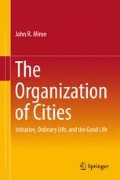Abstract
The Mills model emphasizes the importance of substitution in production by builders and exporters in the spatial organization of the urban economy. Firms are seen to alter their use of land, labor, and capital across the city in response to systematic variations in the price for land (market rent). Mills’ approach is similar to that of Muth (1969) . The Mills and Muth models assume no substitution among goods by consumers. Regardless of how costly accommodation may become as we approach Point O, the consumer always consumes 1.0 unit of accommodation. In this chapter, I now introduce substitution by consumers. I begin with a classic formulation of the Alonso model in which the consumer substitutes between size of land parcel occupied and a composite “other good”. The consumer has a budget that gets expended on commuting cost, land rent, and the other good. In a competitive land market , the rent per unit land at every location adjusts until consumers are indifferent among sites at which they are the highest bidder . Where the price (market rent) for land is relatively high, the consumer consumes less land and possibly more of the other good. This outcome is different from the models in Chaps. 5–10 where the worker is assumed to always consume the same amount of land (and the same amount of the composite other good) regardless of location. This model is then extended to cover the case where the consumer expends both money and time in commuting. Finally, a variant of the model is presented in which the consumer values not the size of the parcel itself, but rather the distance from neighbors .
Access this chapter
Tax calculation will be finalised at checkout
Purchases are for personal use only
Notes
- 1.
Trained as an architect and later to become a demographer, this area of research was only a short part of his life: all the more impressive!.
- 2.
This is reminiscent of the opening of von Thünen (1826).
- 3.
Consumer values each additional unit of land area less and less.
- 4.
Consumer expenditure on a given category of goods and services is a constant proportion of their total spending.
- 5.
Income after deduction of commuting cost.
- 6.
A model of consumer behavior in which the amount of each good or service consumed remains constant regardless of variations in prices.
- 7.
For simplicity of exposition, I omit comparative statics with respect to N.
- 8.
Similar arguments about how increased density does not meet the needs and desires of the population are found in Bruegmann (2005) and Kotkin (2016) .
- 9.
A habitable and self-contained suite of rooms with its own private entrance in a structure that contains multiple dwellings. Normally, this excludes row-houses and semi-detached structures. It includes each dwelling in an apartment building and each unit in a duplex or triplex. Normally, apartments include condominium, cooperative, and units rented month-to-month and excludes suites in hotels and related short-term accommodation.
- 10.
A deduction from the usual cost or price.
- 11.
Following Becker (1981), households purchase goods in the marketplace and then use their own labor together with these goods to produce “commodities”, such as good health, that the household wants.
Author information
Authors and Affiliations
Corresponding author
Rights and permissions
Copyright information
© 2017 Springer International Publishing AG
About this chapter
Cite this chapter
Miron, J.R. (2017). Substitution by Consumers in the Urban Economy. In: The Organization of Cities . Springer, Cham. https://doi.org/10.1007/978-3-319-50100-0_11
Download citation
DOI: https://doi.org/10.1007/978-3-319-50100-0_11
Published:
Publisher Name: Springer, Cham
Print ISBN: 978-3-319-50099-7
Online ISBN: 978-3-319-50100-0
eBook Packages: Economics and FinanceEconomics and Finance (R0)

